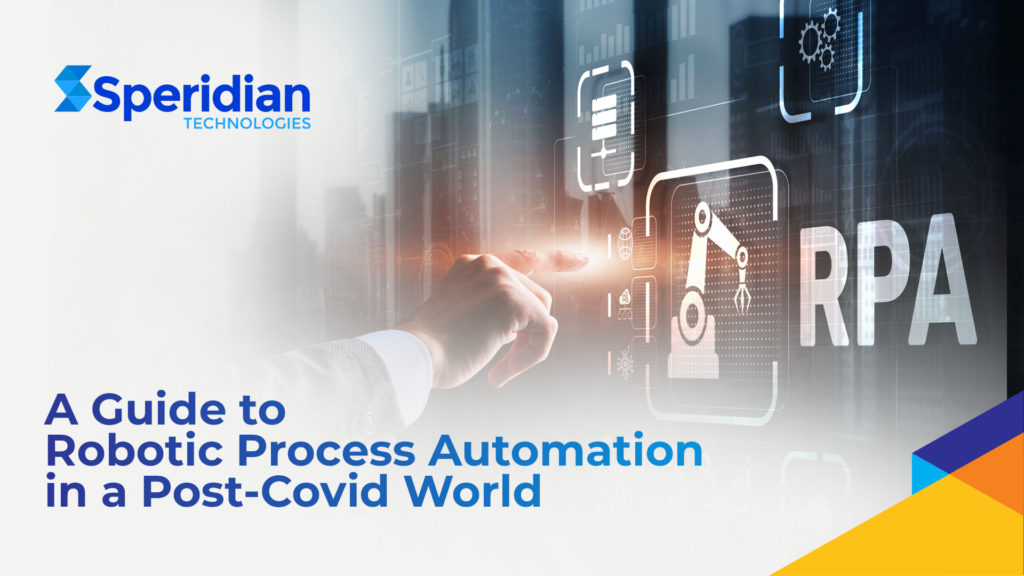A Guide to Robotic Process Automation in a Post-Covid World
The COVID-19 pandemic accelerated disruption and sped up the transition to a digital-first world. In response, organizations are using next-generation technology to innovate and stay ahead of the competition.
One such innovation is Robotic Process Automation (RPA). RPA enables your organization to optimize and automate routine business processes, so that you can focus on more strategic business activities. In fact, RPA has become a savior for many organizations in these difficult times to ensure business continuity when human resources have been reduced.
Integrating RPA with business processes will help advance your organizational capabilities. By removing manual processes and the risk of errors, your organization can reduce costs and save time.
Table of Contents
What is Robotic Process Automation?
Aimed at automating business processes, RPA is an emerging technology that allows organizations to streamline operations by emulating and integrating human interaction within digital systems to execute a business process. A subdiscipline of Artificial Intelligence (AI), software wizards or “bots” are configured and coordinated to execute repetitive manual business processes and human tasks. These bots can interpret, trigger responses, and communicate with other systems in order to perform a variety of tasks.
Organizations are turning to RPA in 2022 to eliminate tedious manual tasks and enable employees to refocus their time on higher-value work. According to the Deloitte Global RPA Survey, 53% of respondents have already started their RPA journey and a further 19% of respondents plan to adopt RPA in the next two years.
How do you start the RPA journey?
Speridian Technologies makes RPA possible through a 4-pillar best-practice approach, called RapidROITM.

Leveraging our RapidROITM approach to Analysis, you can produce incremental value at every stage in successive bursts.
The Analysis can ideally be done in these five stages:
| Weeks 1-2 | Project Initiation and Agreement of Metrics / KPIs / ROI |
| Weeks 3-6 | Initial value analysis, identification of IQuick WinsI, creation of IAnalysis Plan, Governance PlanI |
| Weeks 6-12 | In-depth analysis of High Value / Quick Win processes at sub-process level, Implementation Plan |
| Months 4-6 | Ongoing analysis service – Further in-depth analysis of initial processes as per Analysis and Implementation Plans / Value Analysis & Road-mapping for other divisions |
| Months 7-12 | Ongoing analysis service – As required, in line with Analysis / Implementation Plans of other divisions in scope |
In the first stage, define the agreement of metrics, KPIs, and the overall ROI of the initiative. During this Project Initiation phase, facilitate the delivery of a catalog of candidate processes that are then analyzed and elaborated to a Product Backlog using an Agile-like approach of sprints. Once the Product Backlog is ‘groomed,’ define the Value Points (Cost Savings) and Size Points (Effort) to build each of the Sprint Backlogs based on agreed priorities by the Governance Team.
In the second stage, conduct initial value analysis, identify quick wins, and produce the Analysis Plan and a Governance Plan with governance mechanisms required to implement Enterprise RPA at scale. By using a repetitive and consistent set of core processes that are used throughout the engagement lifecycle, ensure that all goals and objectives will be met across the associated business domains, lines of business, and partners..
For the third stage, produce an in-depth analysis of the quick win processes at a sub-process level and create a recommended Implementation Plan. In this plan, define governance and analysis standards, roles, processes, activities, techniques, tools, and deliverables, as well as associated best practices that should be implemented for each type of solution and/or business domain.
The last two stages of this engagement include two types of ongoing analysis to provide further in-depth analysis of the initial processes, as well as the strategic road mapping of additional processes to various divisions of the company, as desired.
Are you ready for RPA?
Currently, the level of automation in organizations is still limited across industries compared to the level of automation that can be achieved with existing technologies. However, RPA is increasingly becoming an enterprise-level opportunity to improve efficiency across all the departments in an organization. 92% of respondents to the Deloitte Global RPA survey say that RPA met or exceeded their expectations. This was followed by improved quality / accuracy (90%), improved productivity (86%), and cost savings (59%).
Are you ready to start your RPA journey? Speridian is your one-stop implementation partner for Robotic Process Automation. We support the entire RPA lifecycle from implementation and integration to Managed Services around bot governance and maintenance to ensure that you have an effective RPA solution. Let us guide you into the future with RapidROITM and automation that powers your business.
Contact Speridian today to start your RPA journey.
